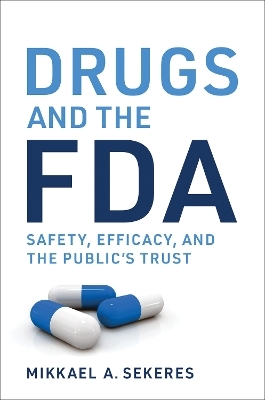
Drugs and the FDA
Safety, Efficacy, and the Public's Trust
Seiten
2024
MIT Press (Verlag)
978-0-262-54839-7 (ISBN)
MIT Press (Verlag)
978-0-262-54839-7 (ISBN)
How the FDA was shaped by public health crises and patient advocacy, told against a background of the contentious hearings on the breast cancer drug Avastin.
Food and Drug Administration approval for COVID-19 vaccines and the controversial Alzheimer’s drug Aduhelm made headlines, but few of us know much about how the agency does its work. Why is the FDA the ultimate US authority on a drug’s safety and efficacy? In Drugs and the FDA, Mikkael Sekeres—a leading oncologist and former chair of the FDA’s cancer drug advisory committee—tells the story of how the FDA became the most trusted regulatory agency in the world. It took a series of tragedies and health crises, as well as patient advocacy, for the government to take responsibility for ensuring the efficacy and safety of drugs and medical devices.
Before the FDA existed, drug makers could hawk any potion, claim treatment of any ailment, and make any promise on a label. But then, throughout the twentieth century, the government was forced to take action when children were poisoned by contaminated diphtheria and smallpox vaccines, an early antibiotic contained antifreeze, a drug prescribed for morning sickness in pregnancy caused babies to be born disfigured, and access to AIDS drugs was limited to a few clinical trials while thousands died. Sekeres describes all these events against the backdrop of the contentious 2011 hearings on the breast cancer drug Avastin, in which he participated as a panel member. The Avastin hearings, he says, put to the test a century of the FDA’s evolution, demonstrating how its system of checks and balances works—or doesn’t work.
Food and Drug Administration approval for COVID-19 vaccines and the controversial Alzheimer’s drug Aduhelm made headlines, but few of us know much about how the agency does its work. Why is the FDA the ultimate US authority on a drug’s safety and efficacy? In Drugs and the FDA, Mikkael Sekeres—a leading oncologist and former chair of the FDA’s cancer drug advisory committee—tells the story of how the FDA became the most trusted regulatory agency in the world. It took a series of tragedies and health crises, as well as patient advocacy, for the government to take responsibility for ensuring the efficacy and safety of drugs and medical devices.
Before the FDA existed, drug makers could hawk any potion, claim treatment of any ailment, and make any promise on a label. But then, throughout the twentieth century, the government was forced to take action when children were poisoned by contaminated diphtheria and smallpox vaccines, an early antibiotic contained antifreeze, a drug prescribed for morning sickness in pregnancy caused babies to be born disfigured, and access to AIDS drugs was limited to a few clinical trials while thousands died. Sekeres describes all these events against the backdrop of the contentious 2011 hearings on the breast cancer drug Avastin, in which he participated as a panel member. The Avastin hearings, he says, put to the test a century of the FDA’s evolution, demonstrating how its system of checks and balances works—or doesn’t work.
Mikkael A. Sekeres is Professor of Medicine and Chief of the Division of Hematology at the Sylvester Comprehensive Cancer Center, University of Miami Miller School of Medicine, and former Chair of the Oncologic Drugs Advisory Committee of the FDA. A regular contributor to the Well section of the New York Times, he is the author of When Blood Breaks Down: Life Lessons from Leukemia (MIT Press).
Preface ix
1 This Little Drug Came to Market... 1
2 And Finally, Efficacy 29
3 The Moxie to Do Battle 53
4 Trials and Tribulations 77
5 Starve a Tumor, Feed an Industry 107
6 A Viral Scourge 131
7 Silence = Death 155
8 The FDA Makes Its Case 185
9 The Avastin Decision 215
Epilogue 247
Acknowledgments 259
Appendix 261
Notes 267
Index 299
| Erscheinungsdatum | 25.01.2024 |
|---|---|
| Zusatzinfo | 20 BLACK AND WHITE ILLUS. |
| Sprache | englisch |
| Maße | 152 x 229 mm |
| Themenwelt | Medizin / Pharmazie ► Pflege |
| Recht / Steuern ► EU / Internationales Recht | |
| Recht / Steuern ► Privatrecht / Bürgerliches Recht ► Medizinrecht | |
| ISBN-10 | 0-262-54839-9 / 0262548399 |
| ISBN-13 | 978-0-262-54839-7 / 9780262548397 |
| Zustand | Neuware |
| Informationen gemäß Produktsicherheitsverordnung (GPSR) | |
| Haben Sie eine Frage zum Produkt? |
Mehr entdecken
aus dem Bereich
aus dem Bereich
Vorschriftensammlung
Buch | Softcover (2024)
C.F. Müller (Verlag)
55,00 €


